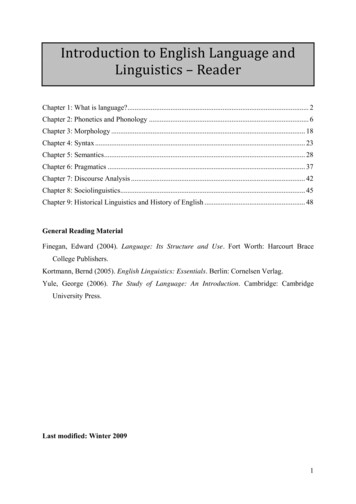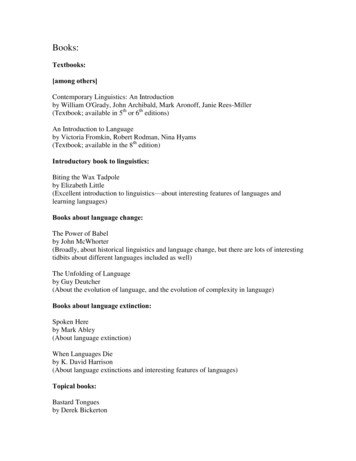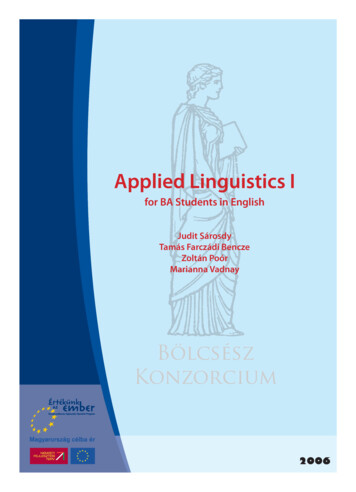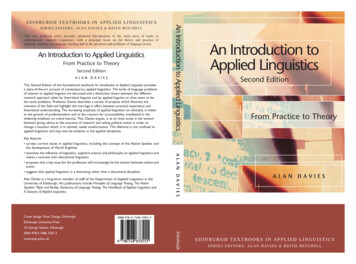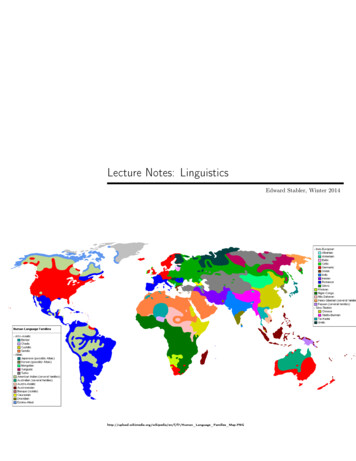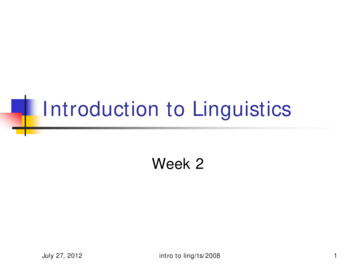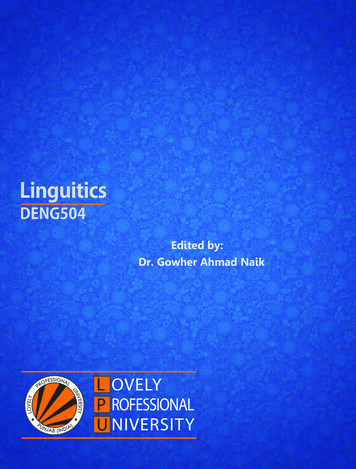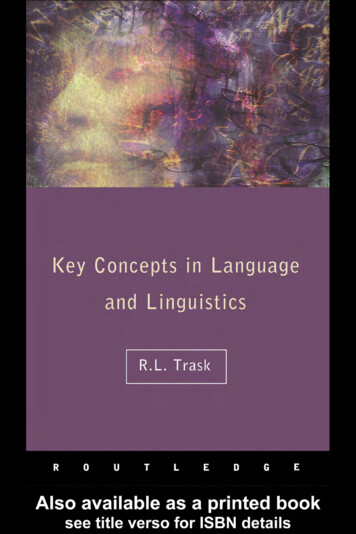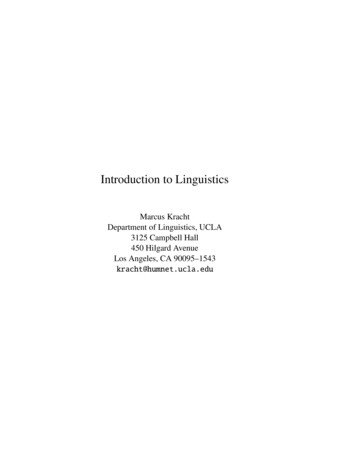
Transcription
Introduction to LinguisticsMarcus KrachtDepartment of Linguistics, UCLA3125 Campbell Hall450 Hilgard AvenueLos Angeles, CA 90095–1543kracht@humnet.ucla.edu
2ContentsContentsLecture 1: Introduction . . . . . . . . . . . . . . . . . . . . . . . . . . . . . . . . . . . . . . . . . . . . . . . . . 3Lecture 2: Phonetics . . . . . . . . . . . . . . . . . . . . . . . . . . . . . . . . . . . . . . . . . . . . . . . . . . . 12Lecture 3: Phonology I . . . . . . . . . . . . . . . . . . . . . . . . . . . . . . . . . . . . . . . . . . . . . . . . . 24Lecture 4: Phonology II . . . . . . . . . . . . . . . . . . . . . . . . . . . . . . . . . . . . . . . . . . . . . . . . 41Lecture 5: Phonology III . . . . . . . . . . . . . . . . . . . . . . . . . . . . . . . . . . . . . . . . . . . . . . . 55Lecture 6: Phonology IV . . . . . . . . . . . . . . . . . . . . . . . . . . . . . . . . . . . . . . . . . . . . . . . 66Lecture 7: Morphology I . . . . . . . . . . . . . . . . . . . . . . . . . . . . . . . . . . . . . . . . . . . . . . . 79Lecture 8: Syntax I . . . . . . . . . . . . . . . . . . . . . . . . . . . . . . . . . . . . . . . . . . . . . . . . . . . . 86Lecture 9: Syntax II . . . . . . . . . . . . . . . . . . . . . . . . . . . . . . . . . . . . . . . . . . . . . . . . . . . 98Lecture 10: Syntax III . . . . . . . . . . . . . . . . . . . . . . . . . . . . . . . . . . . . . . . . . . . . . . . . 108Lecture 11: Syntax IV . . . . . . . . . . . . . . . . . . . . . . . . . . . . . . . . . . . . . . . . . . . . . . . . 115Lecture 12: Syntax V . . . . . . . . . . . . . . . . . . . . . . . . . . . . . . . . . . . . . . . . . . . . . . . . . 124Lecture 13: Morphology II . . . . . . . . . . . . . . . . . . . . . . . . . . . . . . . . . . . . . . . . . . . . 132Lecture 14: Semantics I . . . . . . . . . . . . . . . . . . . . . . . . . . . . . . . . . . . . . . . . . . . . . . . 140Lecture 15: Semantics II . . . . . . . . . . . . . . . . . . . . . . . . . . . . . . . . . . . . . . . . . . . . . . 145Lecture 16: Semantics III . . . . . . . . . . . . . . . . . . . . . . . . . . . . . . . . . . . . . . . . . . . . . 152Lecture 17: Semantics IV . . . . . . . . . . . . . . . . . . . . . . . . . . . . . . . . . . . . . . . . . . . . . 161Lecture 18: Semantics V . . . . . . . . . . . . . . . . . . . . . . . . . . . . . . . . . . . . . . . . . . . . . . 168Lecture 19: Language Families and History of Languages . . . . . . . . . . . . . . 175
Lecture 1: IntroductionLanguages are sets of signs. Signs combine an exponent (a sequenceof letters or sounds) with a meaning. Grammars are ways to generatesigns from more basic signs. Signs combine a form and a meaning,and they are identical with neither their exponent nor with their meaning.Before we start. I have tried to be as explicit as I could in preparing these notes.You will find that some of the technicalities are demanding at first sight. Donot panic! You are not expected to master these technicalities right away. Thetechnical character is basically due to my desire to be as explicit and detailed aspossible. For some of you this might actually be helpful. If you are not amongthem you may want to read some other book on the side (which I encourage you todo anyway). However, linguistics is getting increasingly formal and mathematical,and you are well advised to get used to this style of doing science. So, if you donot understand right away what I am saying, you will simply have to go over itagain and again. And keep asking questions! New words and technical termsthat are used for the first time are typed in bold-face. If you are supposed toknow what they mean, a definition will be given right away. The definition isvalid throughout the entire course, but be aware of the fact that other people mightdefine things differently. This applies when you read other books, for example.You should beware of possible discrepancies in terminology. If you are not givena definition elsewhere, be cautious. If you are given a different definition it does not mean that the other books get it wrong. The symbolin the margin signalssome material that is difficult, and optional. Such passages are put in for thosewho want to get a perfect understanding of the material; but they are not requriedknowledge.(End of note)Language is a means to communicate, it is a semiotic system. By that wesimply mean that it is a set of signs. Its A sign is a pair consisting—in the wordsof Ferdinand de Saussure—of a signifier and a signified. We prefer to call thesignifier the exponent and the signified the meaning. For example, in English thestring /dog/ is a signifier, and its signified is, say, doghood, or the set of all dogs.(I use the slashes to enclose concrete signifiers, in this case sequences of letters.)Sign systems are ubiquitous: clocks, road signs, pictograms—they all are parts of
4Lecture 1: Introductionsign systems. Language differs from them only in its complexity. This explainswhy language signs have much more internal structure than ordinary signs. Fornotice that language allows to express virtually every thought that we have, andthe number of signs that we can produce is literally endless. Although one mayfind it debatable whether or not language is actually infinite, it is clear that weare able to understand utterances that we have never heard before. Every year,hundreds of thousands of books appear, and clearly each of them is new. If itwere the same as a previously published book this would be considered a breachof copyright! However, no native speaker of the language experiences troubleunderstanding them (apart from technical books).It might be far fetched, though, to speak of an entire book as a sign. Butnothing speaks against that. Linguists mostly study only signs that consist of justone sentence. And this is what we shall do here, too. However, texts are certainlymore than a sequence of sentences, and the study of discourse (which includestexts and dialogs) is certainly a very vital one. Unfortunately, even sentences areso complicated that it will take all our time to study them. The methods, however,shall be useful for discourse analysis as well.In linguistics, language signs are constituted of four different levels, not justtwo: phonology, morphology, syntax and semantics. Semantics deals withthe meanings (what is signified), while the other three are all concerned with theexponent. At the lowest level we find that everything is composed from a smallset of sounds, or—when we write—of letters. (Chinese is exceptional in that thealphabet consists of around 50,000 ‘letters’, but each sign stands for a syllable—asequence of sounds, not just a single one.) With some exceptions (for exampletone and intonation) every utterance can be seen as a sequence of sounds. Forexample, /dog/ consists of three letters (and three sounds): /d/, /o/ and /g/. Inorder not to confuse sounds (and sound sequences) with letters we denote thesounds by enclosing them in square brackets. So, the sounds that make up [dog]are [d], [o] and [g], in that order. What is important to note here is that soundsby themselves in general have no meaning. The decomposition into sounds hasno counterpart in the semantics. Just as every signifier can be decomposed intosounds, it can also be decomposed into words. In written language we can spot thewords by looking for minimal parts of texts enclosed by blanks (or punctuationmarks). In spoken language the definition of word becomes very tricky. Thepart of linguistics that deals with how words are put together into sentences iscalled syntax. On the other hand, words are not the smallest meaningful units of
Lecture 1: Introduction5language. For example, /dogs/ is the plural of /dog/ and as such it is formed bya regular process, and if we only know the meaning of /dog/ we also know themeaning of /dogs/. Thus, we can decompose /dogs/ into two parts: /dog/ and /s/.The minimal parts of speech that bear meaning are called morphemes. Often, itis tacitly assumed that a morpheme is a part of a word; bigger chunks are calledidioms. Idioms are /kick the bucket/, /keep taps on someone/, and so on.The reason for this division is that while idioms are intransparent as far as theirmeaning is concerned (if you die you do not literally kick a bucket), syntacticallythey often behave as if they are made from words (for example, they inflect: /Johnkicked the bucket/).So, a word such as ‘dogs’ has four manifestations: its meaning, its soundstructure, its morphological structure and its syntactic structure. The levels ofmanifestation are also called strata. (Some use the term level of representation.) We use the following notation: the sign is given by enclosing the string inbrackets: ‘dog’. [dog]P denotes its phonological structure, [dog]M its morphological structure, [dog]L its syntactic structure and [dog]S its semantical structure. Ialso use typewriter font for symbols in print. For the most part we analyse language as written language, unless otherwise indicated. With that in mind, we have[dog]P /dog/. The latter is a string composed from three symbols, /d/, /o/ and/g/. So, ‘dog’ refers to the sign whose exponent is written here /dog/. We shallagree on the following.Definition 1 A sign is a quadruple hπ, µ, λ, σi, where π is its exponent (or phonological structure), µ its morphological structure, λ its syntactic structure and σits meaning (or semantic structure).We write signs vertically, in the following way.(1) σ λ µ πThis definition should not be taken as saying something deep. It merely fixes thenotion of a linguistic sign, saying that it consists of nothing more (and nothingless) than four things: its phonological structure, its morphological structure, itssyntactic structure and its semantic structure. Moreover, in the literature there are
Lecture 1: Introduction6numerous different definitions of signs. You should not worry too much here: thepresent definition is valid throughout this book only. Other definitions have othermerits.The power of language to generate so many signs comes from the fact that ithas rules by which complex signs are made from simpler ones.(2)Cars are cheaper this year.In (2), we have a sentence composed from 5 words. The meaning of each word isenough to understand the meaning of (2). Exactly how this is possible is one question that linguistics has to answer. (This example requires quite a lot of machineryto be solved explicitly!) We shall illustrate the approach taken in this course. Weassume that there is a binary operation , called merge, which takes two signsand forms a new sign. operates on each of the strata (or levels of manifestation)independently. This means that there are four distinct operations, P , M , L , andS , which simultaneously work together as follows.(3) σ1 σ2 λ1 λ2 µ1 µ2 π1π2σ1λ1µ1π1SLMPσ2λ2µ2π2 Definition 2 A language is a set of signs. A grammar consists of a set of signs(called lexicon) together with a finite set of functions that each operate on signs.Typically, though not necessarily, the grammars that linguists design for naturallanguages consist in the lexicon plus a single binary operation of merge. Theremay also be additional operations (such as movement), but let’s assume for themoment that this is not so. Such a grammar is said to generate the followinglanguage ( set of signs) L:À Each member of the lexicon is in L.Á If S and S ′ are in L, then so is S S ′ . Nothing else is in L.
Lecture 1: Introduction7(Can you guess what a general definition would look like?) We shall now givea glimpse of how the various representations look like and what these operationsare. It will take the entire course (and much more) to understand the preciseconsequences of Definitions 1 and 2 and the idea that operations are defined oneach stratum independently. But it is a very useful one in that it forces us to beclear and concise. Everything has to be written into one of the representations inorder to have an effect on the way in which signs combine and what the effect ofcombination is.For example, P is typically concatenation, with a blank added. Let us represent strings by x, y etc., and concatenation by a . So,(4)(5)daca xy dacxyadfa 2a xy adf xyNotice that visually, 2 (‘blank’) is not represented at the end of a word. In computer books one often uses the symbol to represent the blank. (Clearly, thoughthe symbol is different from the blank!) Blank is a symbol (on a typewriter youhave to press space to get it. So, xa 2 is not the same as x! Now we have(6) xP y : xa 2a yFor example, the sign ‘this year’ is composed from the signs ‘this’ and ‘year’.And we have(7)this year [this year]P [this]PP[year]P thisa 2a yearThis, however, is valid only for words and only for written language. The composition of smaller units is different. No blank is inserted. For example, the sign‘car’ the plural sign ‘s’ (to give it a name) compose to give the sign with exponent /cars/, not /car s/. Moreover, the plural of /man/ is /men/, so it is not at allformed by adding /s/. We shall see below how this is dealt with.Morphology does not get to see the individual makeup of its units. In fact,the difference between ‘car’ and ‘cat’ is morphologically speaking as great as thatbetween ‘car’ and ‘moon’. Also, both are subject to the same morphological rulesand behave in the same way, for example form the plural by adding ‘s’. Thatmakes them belong to the same noun class. Still, they are counted as differentmorphemes. This is because they are manifested differently (the sound structure isdifferent). Therefore we distinguish between a morpheme and its morphological
8Lecture 1: Introductionstructure. The latter is only the portion that is needed on the morphologicalstratum to get everything right.Definition 3 A morpheme is an indecomposable sign.A morpheme can only be defined relative to a grammar. If we have only , thenS is a morpheme of there are no S ′ and S ′′ with S S ′ S ′′ . (If you suspectthat essentially the lexicon may consist in all and only the morphemes, you areright. Though the lexicon may contain more elements, it cannot contain less.) Aword is something that is enclosed by blanks and/or punctuation marks. So thepunctuation marks show us that a morpheme is a word. To morphology, ‘car’ isknown as a noun that takes an s-plural. We write#" : n(8) : s-plto say that the item is of morphological category ‘n’ (nominal) and that it hasinflectional category ‘s-pl’ (which will take care of the fact that its plural will beformed by adding ‘s’).To the syntactic stratum the item ‘cars’ is known only as a plural noun despitethe fact that it consists of two morphs. Also, syntax is not interested in knowinghow the plural was formed. The syntactic representation therefore is the following.#" : N(9) : plThis says that we have an object of category N whose number is plural. We shallreturn to the details of the notation later during the course. Now, for the merge onthe syntactic stratum let us look again at ‘this year’. The second part, ‘year’ is anoun, the first a determiner. The entire complex has the category of a determinerphrase (DP). Both are singular. Hence, we have that in syntax## ""#" : DP : N : DL (10) : sg : sg : sgThis tells us very little about the action of L . In fact, large parts of syntactictheory are consumed by finding out what merge does in syntax!
Lecture 1: Introduction9Semantical representations are too complex to be explained here (it requires acourse in model-theory or logic to understand them). We shall therefore not saymuch here. Fortunately, most of what we shall have to say here will be clear evenwithout further knowledge of the structures. Suffice it to say, for example, that themeaning of ‘car’ is the set of all cars (though this is a massive simplification thisis good enough for present purposes); it is clearly different from the meaning of‘cat’, which is the set of all cats. Further, the meaning of ‘cars’ is the set of all setsof cars that have at least two members. The operation of forming the plural takesa set A and produces the set of all subsets of A that have at least two members. So:(11)[s]S :{ , , , } 7 {{ , }, { , }, { , }, { , }, { , }, { , },{ , , }, { , , }, { , , }, { , , }, { , , },{ , , , }}With this defined we can simply say that M(N) if defined,(12)M S N : N(M) otherwise.S; is function application.The function is [s]S and the argument is [car]S , which is the set of all cars. Bydefinition, what we get is the set of all sets of cars that have at least two membersin it. Our typographical convention is the following. For a given word, say ‘cat’the semantics is denoted by sans-serife font plus an added prime: cat′ .Here is a synopsis of the merge of ‘this’ and ‘year’. this′ " " year′ # " this′ (year′ ) ## DNDP sgsgsg " # "# "#(13) nnnp abl s-pl thisyearthis year (Here, ‘abl’ stands for ‘ablaut’. What it means is that the distinction between singular and plural is signaled only by the vowel. In this case it changes from [ı]to [i:]. means: no value.) One may ask why it is at all necessary to distinguish morphological from syntactic representation. Some linguists sharply divide
10Lecture 1: Introductionbetween lexical and syntactical operations. Lexical operations are those that operate on units below the level of words. So, the operation that combines ‘car’and plural is a lexical operation. The signs should have no manifestation on thesyntactical stratum, and so by definition, then, they should not be called signs.However, this would make the definition unnecessarily complicated. Moreover,linguists are not unanimous in rejecting syntactic representations for morphemes,since it poses more problems than it solves (this will be quite obvious for so-calledpolysynthetic languages). We shall not attempt to solve the problem here. Opinions are quite diverse and most linguists do accept that there is a separate level ofmorphology.A last issue that is of extreme importance in linguistics is that of deep and surface structure. Let us start with phonology. The sound corresponding to the letter/l/ differs from environment to environment (see Page 525 of Fromkin et. al.).The ‘l’ in the pronunication of /slight/ is different from the ‘l’ in (the pronunciation of) /listen/. If we pronounce /listen/ using the ‘l’ sound of /slight/we get a markedly different result (it sounds a bit like Russian accent). So, oneletter has different realizations, and the difference is recognized by the speakers.However, the difference between these sounds is redundant in the language. Infact, in written language they are represented by just one symbol. Thus, one distinguishes a phone ( sound) from a phoneme ( set of sounds). While phonesare language independent, phonemes are not. For example, the letter /p/ has twodistinct realizations, an aspirated and an unaspirated one. It is aspirated in /pot/but unaspirated in /spit/. Hindi recognizes two distinct phonemes here. A similar distinction exists in all other strata, though we shall only use the distinctionbetween morph and morpheme. A morpheme is a set of morphs. For example,the plural morpheme contains a number of morphs. One of them consists in theletter /s/, another in the letters /en/ (which are appended, as in /ox/:/oxen/), athird is zero (/fish/:/fish/). And some more. The morphs of a morpheme arecalled allomorphs of each other. If a morpheme has several allomorphs, how dowe make sure that the correct kind of morph is applied in combination? For example, why is the plural of /car/ not /caren/ or /car/? The answer lies in themorphological representation. Indeed, we have proposed that morphological representations contain information about word classes. This means that for nouns itcontains information about the kind of plural morph that is allowed to attach to it.If one looks carefully at the setup presented above, the distinction between deepand surface stratum is however nonexistent. There is no distinction between morpheme and morph. Thus, either there are no morphs or there are no morphemes.
Lecture 1: Introduction11Both options are theoretically possible.Some notes. The idea of stratification is implicit in many syntactic theories.There are differences in how the strata look like and how many there are. Transformational grammar recognizes all four of the strata (they have been calledLogical Form (for the semantical stratum) S-structure (for syntax) and PhoneticForm or PF (for phonological stratum). Morphology has sometimes been considered a separate, lexical stratum, although some theories (for example DistributedMorphology) try to integrate it into the overall framework. Lexical FunctionalGrammar (LFG) distinguishes c(onstituent)-structure ( syntax), a(rgument)structure, f(unctional)-structure and m(orphological)-structure.There has also been Stratificational Grammar, which basically investigatedthe stratal architecture of language. The difference with the present setup is thatStratificational Grammar assumes independent units at all strata. For example,a morpheme is a citizen of the morphological stratum. The morpheme ‘car’ isdifferent from the morpheme ‘cat’, for example. Moreover, the lexeme ‘car’ isonce again different from the morpheme ‘car’, and so on. This multiplies thelinguistic ontology beyond need. Here we have defined a morpheme to be a signof some sort, and so it has just a manifestation on all strata rather than belongingto any of them. That means that our representation shows no difference on themorphological stratum, only on the semantical and the phonological stratum.Alternative Reading. I recommend [Fromkin, 2000] for alternative perspective. Also [O’Grady et al., 2005] is worthwhile though less exact.
Lecture 2: PhoneticsPhonetics is the study of sounds. To understand the mechanics ofhuman languages one has to understand the physiology of the humanbody. Letters represent sounds in a rather intricate way. This hasadvantages and disadvantages. To represent sounds by letters in anaccurate and uniform way the International Phonetic Alphabet (IPA)was created.We begin with phonology and phonetics. It is important to understand the difference between phonetics and phonology. Phonetics is the study of actual sounds ofhuman languages, their production and their perception. It is relevant to linguistics for the simple reason that the sounds are the primary physical manifestation oflanguage. Phonology on the other hand is the study of sound systems. The difference is roughly speaking this. There are countless different sounds we can make,but only some count as sounds of a language, say English. Moreover, as far asEnglish is concerned, many perceptibly distinct sounds are not considered ‘different’. The letter /p/, for example, can be pronounced in many different ways, withmore emphasis, with more loudness, with different voice onset time, and so on.From a phonetic point of view, these are all different sounds; from a phonologicalpoint of view there is only one (English) sound, or phoneme: [p].The difference is very important though often enough it is not evident whethera phenomenon is phonetic in nature or phonological. English, for example, hasa basic sound [t]. While from a phonological point of view there is only onephoneme [t], there are infinitely many actual sounds that realize this phoneme.So, while there are infinitely many different sounds for any given language thereare only finitely many phonemes, and the upper limit is around 120. English has40 (see Table 7). The difference can be illustrated also with music. There is acontinuum of pitches, but the piano has only 88 keys, so you can produce only88 different pitches. The chords of the piano are given, so that the basic soundcolour and pitch cannot be altered. But you can still manipulate the loudness,for example. Sheet music reflects this state of affairs in the same way as writtenlanguage. The musical sounds are described by discrete signs, the keys. Returningnow to language: the difference between various different realizations of the letter/t/, for example, are negligeable in English and often enough we cannot even tellthe difference between them. Still, if we recorded the sounds and mapped themout in a spectrogram we could actually see the difference. (Spectrograms are one
Lecture 2: Phonetics13Table 1: The letter /x/ in various PortugueseSpanishPinyin of t instrument in phonetics because they visualize sounds so that you cansee what you often even cannot hear.) Other languages cut the sound continuumin a different way. Not all realizations of /t/ in English sound good in French,for example. Basically, French speakers pronounce /t/ without aspiration. Thismeans that if we think of the sounds as forming a ‘space’ the so-called basicsounds of a language occupy some region of that space. These regions vary fromone language to another.Languages are written in alphabets, and many use the Latin alphabet. It turnsout that not only is the Latin alphabet not always suitable for other languages,orthographies are often not a reliable source for pronunciation. English is a casein point. To illustrate the problems, let us look at the following tables (taken from[Coulmas, 2003]). Table 1 concerns the values of the letter /x/ in different languages: As one can see, the correspondence between letters and sounds is notat all uniform. On the other hand, even in one and the same language the correspondence can be nonuniform. Table 2 lists ways to represent [ ] is Englishby letters. Basically any of the vowel letters can represent [ ]. This mismatchhas various reasons, a particular one being language change and dialectal difference. The sounds of a language change slowly over time. If we could hear atape recording of English spoken, say, one or two hundred years ago in one andthe same region, we would surely notice a difference. The orthography howevertends to be conservative. The good side about a stable writing system is that wecan (in principle) read older texts even if we do not know how to pronounce them.Second, languages with strong dialectal variation often fix writing according to
Lecture 2: Phonetics14Table 2: The sound [ ] in igecircusone of the dialects. Once again this means that documents are understood acrossdialects, even though they are read out differently.I should point out here that there is no unique pronunciation of any letter ina language. More often than not it has quite distinct vaues. For example, theletter /p/ sounds quite different in /photo/ as it does in /plus/. In fact, the sounddescribed by /ph/ is the same as the one normally described by /f/ (for examplein /flood/). The situation is that we nevertheless ascribe a ‘normal’ value to aletter (which we use when pronouncing the letter in isolation or in reciting thealphabet). This connection is learned in school and is part of the writing system,by which I mean more than just the rendering of words into sequences of letters.Notice a curious fact here. The letter /b/ is pronounced like /bee/ in English,with a subsequent vowel that is not part of the value of the letter. In Sanskrit, theprimitive consonantal letters represent the consonant plus [a], while the recitationof the letter is nowadays done without it. For example, the letter for “b” hasvalue [b ] when used ordinarily, while it is recited [b]. If one does not want apronunciation with schwa, the letter is augmented by a stroke.In the sequel I shall often refer to the pronunciation of a letter; by that I meanthe standard value assigned to it in reciting the alphabet, however without theadded vowel. This recipe is, I hope, reasonably clear, though it has shortcomings(the recitation of /w/ reveals little of the actual sound value).The disadvantage for the linguist is that the standard orthographies have to belearned (if you study many different languages this can be a big impediment) andsecond they do not reveal what is nevertheless important: the sound quality. Forthat reason one has agreed on a special alphabet, the so-called International Phonetic Alphabet (IPA). In principle this alphabet is designed to give an accurate
Lecture 2: Phonetics15written transcription of sounds, one that is uniform for all languages. Since theIPA is an international standard, it is vital that one understands how it works (andcan read or write using it). The complete set of symbols is rather complex, butluckily one does not have to know all of it.The Analysis of Speech SoundsFirst of all, the continuum of speech is broken up into a sequence of discreteunits, which we referred to as sounds. Thus we are analysing language utterancesas sequences of sounds. Right away we mention that there is an exception. Intonation and stress are an exception to this. The sentences below are distinct onlyin intonation (falling pitch versus falling and rising pitch).(14)(15)You spoke with the manager.You spoke with the manager?Also, the word /protest/ has two different pronunciations; when it is a noun thestress is on the first syllable, when it is a verb it is on the second. Stress andintonation obviously affect the way in which the sounds are produced (changingloudness and / or pitch), but in terms of decomposition of an utterance into segments intonation and stress have to be taken apart. We shall return to stress later.Suffice it to say that i
puter books one often uses the symbol to represent the blank. (Clearly, though the symbol is different from the blank!) Blank is a symbol (on a typewriter you have to press space to get it. So, xa is not the same as x! Now we have (6) x P y : xa a y For example, the sign
